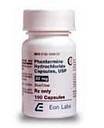|
paxil drug interaction:
|
paxil drug interaction Tely twice or greater for PAXIL CR compared to placebo) included the following: PAXIL CR Placebo (n = 212) (n = 211) Nausea 3.7% 0.5% Asthenia 1.9% 0.5% Dizziness 1.4% 0.0% Somnolence 1.4% 0.0% In a placebo-controlled study of elderly patients with major depressive disorder paxil drug interaction, 13% (13 104) of patients treated with PAXIL CR discontinued due to an adverse event. Events meeting the above criteria included the following: PAXIL CR Placebo (n = 104) (n = 109) Nausea 2.9% 0.0% Headache 1.9% 0.9% Depression 1.9% 0.0% LFT’s abnormal 1.9% 0.0% Panic Disorder: Eleven percent (50 444) of patients treated with PAXIL CR in panic disorder studies discontinued treatment due t paxil drug interaction.
paxil drug interaction O an adverse event. Events meeting the above criteria included the following: PAXIL CR Placebo (n = 444) (n = 445) Nausea 2.9% 0.4% Insomnia 1.8% 0.0% Headache 1.4% 0.2% Asthenia 1.1% 0.0% Social Anxiety Disorder: Three percent (5 186) of patients treated with PAXIL CR in the social anxiety disorder study discontinued treatment due to an adverse event. Events meeting the above criteria included the following: PAXIL CR Placebo (n = 186) (n = 184) Nausea 2.2% 0.5% Headache 1.6% 0.5% Diarrhea 1.1% 0.5% Premenstrual Dysphoric Disorder: Spontaneously reported adverse events were monitored in studies of both continuous and intermittent dosing of PAXIL CR in the treatment of PMDD. Generally paxil drug interaction, there were few differences in the adverse event profiles of the 2 dosing regimens. Thirteen percent (88 681) of patients treated with PAXIL CR in PMDD studies of continuous dosing discontinued treatment due to an adverse event. The most common events (& 179; 1%) associated with discontinuation in either group treated with PAXIL CR with an incidence rate that is at least twice that of placebo in PMDD trials that employed a continuous dosing regimen are shown in the following table. This table also shows those events that were dose dependent (indicated with an asterisk) as defined as events having an incidence rate with 25 mg of PAXI.
paxil drug interaction Atment of PMDD. Generally paxil drug interaction, there were few differences in the adverse event profiles of the 2 dosing regimens. Thirteen percent (88 681) of patients treated with PAXIL CR in PMDD studies of continuous dosing discontinued treatment due to an adverse event. The most common events (& 179; 1%) associated with discontinuation in either group treated with PAXIL CR with an incidence rate that is at least twice that of placebo in PMDD trials that employed a continuous dosing regimen are shown in the following table. This table also shows those events that were dose dependent (indicated with an asterisk) as defined as events having an incidence rate with 25 mg of PAXIL.
paxil drug interaction 
paxil drug interaction | | | | | |
paxil drug interaction
|
|
Etine (Strattera), cimetidine (Tagamet), lithium (Lithobid, Eskalith), risperidone (Risperdal), St. John's wort, tramadol (Ultram), or tryptophan (also called L-tryptophan); heart rhythm medication such as flecainide (Tambocor) or propafenone (Rhythmol); a blood thinner such as warfarin (Coumadin); any other antidepressants such as amitriptyline (Elavil), citalopram (Celexa), escitalopram (Lexapro), fluoxetine (Prozac, Sarafem), fluvoxamine (Luvox), imipramine (Tofranil), nortriptyline (Pamelor), or sertraline (Zoloft); a phenothiazine such as prochlorperazine (Compazine), chlorpromazine (Thorazine), fluphenazine (Prolixin), mesoridazine (Serentil), and others; or almotriptan (Axert), frovatriptan (Frova), sumatriptan (Imitrex), naratriptan (Amerge), rizatriptan (Maxalt), or zolmitriptan (Zomig). If you are using any of these drugs, you may not be able to use Paxil, or you may need dosage adjustments or special tests during treatment. There may be other drugs not listed that can affect Paxil. Tell your doctor about all the prescription and over-the-counter medications you use. This includes vitamins, minerals, herbal products, and drugs prescribed by other doctors. Do not start using a new medication without telling your doctor. Where can I get more information on Paxil? Your pharmacist has additional information about Paxil written for health professionals that you may read. What does my medication look like? Paroxetine is available with a prescription under the brand names Paxil, Paxil CR and Pexeva. Other brand or generic formulations may also be available. Ask your phar
| Paxil withdrawl | Lexapro vs paxil | Paxil prozac | Order paxil | Paxil suicide | Information on paxil | Online paxil | [ Phentermine ]
|
|

